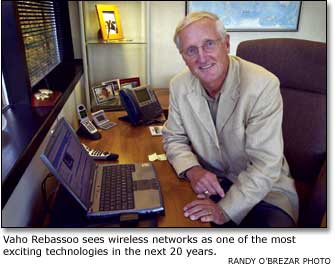| Designing architecture
SSG's
Vaho Rebassoo plans for the
infrastructure of collaborative teaming
BY R. JEFF WOOD

 It
might come as a surprise to those who don't know what network architecture
is, but CEOs around the world are suddenly paying attention to network
architects. Business leaders are hoping to position their companies
for the strategic advantages promised by business-to-business e-commerce,
the virtual workplace and collaborative teaming between geographically
separated sites. It
might come as a surprise to those who don't know what network architecture
is, but CEOs around the world are suddenly paying attention to network
architects. Business leaders are hoping to position their companies
for the strategic advantages promised by business-to-business e-commerce,
the virtual workplace and collaborative teaming between geographically
separated sites.
As the chief technology officer at Shared Services Group,
Vaho Rebassoo leads the team developing the computing and
network architecture plan for Boeing. This plan provides the
foundation for expanding and enhancing the services delivered
to all the business units via the Boeing network.
This work contributes to efforts by the Enterprise Network
Centric Architecture team, led by Boeing Chief Information
Officer Scott Griffin. Computing and network architecture
is an important component of this companywide initiative
to apply, within Boeing, network-centric strategies similar
to those that Boeing is proposing and delivering to the U.S.
military in support of the Future Combat Systems program.
"Whenever we talk about e-enabling employees and moving toward
network-centric operations, we're talking about
network architecture," Rebassoo said. "The challenge is to design and install
the common 'plumbing' that allows computers and systems throughout the company
to share information, while giving the various business units flexibility to
purchase or develop information technologies that provide
strategic advantages."
Rebassoo cites the wide variety of wireless devices becoming
available—Internet-capable cell phones, wireless notebook computers, personal
digital assistants and hybrids
of these devices—to illustrate the challenge. "A business unit could determine
that any one of these is essential to the unit's
competitive advantage," he said. "When that happens, the network must be ready
to accommodate those devices."
The first phase of the architecture plan recently
received a favorable response from the corporate technology council and the
Office of the Chairman, a milestone Rebassoo counts among his
team's most significant
achievements.
Rebassoo came to the abstract realm of network architecture
from an early fascination with the much more concrete world of
computing and telecommunications
hardware. "It's
all based on the silicon chip—essentially a piece of hardened
sand," he said. "You etch a microscopic pattern on it, run a little electricity
through it, and it can store data [and] perform logic functions that transform
bits of data into useful
information."
Designing ways to connect those chips into working systems was
the challenge that took Rebassoo from a bachelor's degree at Harvard to a master's
degree and a doctorate from the University of
Washington.
Rebassoo gained
experience applying his
learning at the Pentagon Telecommunications Center, where he helped design the
pioneering
electronic messaging hub for the network that links
U.S. military ships, bases and embassies around the world.
Rebassoo then accepted a position at Bell Laboratories
where he wrote the business case for the Class 5 Electronic
Switching System, which is still at the heart of the U.S. voice
telecommunication network.
Rebassoo came to Boeing to lead the Boeing Telephone
Service Modernization Program. "The Boeing telephone network is one of the largest
privately owned and operated telephone
networks in the world," he said. "The chance to get in on the design and implementation
of the network architecture
was a once-in-a-lifetime opportunity."
Asked if he worries that network technology
might hamper Boeing's airline customers by making travel unnecessary, Rebassoo
said he instead sees it as removing obstacles to
travel. "You won't have to worry about being out of touch
while you are away."
Shared Services Group is leading the way in adopting the
virtual workplace. Rather than converging on a fixed workplace every morning,
SSG employees are connecting to the
Boeing network from designated "hoteling" stations in many Boeing buildings.
From locations outside Boeing, including customer and supplier facilities, employees
connect via
secure Internet connections.
"This is a great example of how networked communications
can help the company become lean, agile and collaborative," Rebassoo said. Collaborative
technologies, such as Virtual Team Room, add another dimension to this efficiency.
Rebassoo sees wireless networks, along with biotechnology,
as the most exciting technologies in the next 20 years. "Advances in biotechnology may make it possible
to live for
100 years," he said. "But network technology will give you the ability to decide
how you use all that time."
| 
